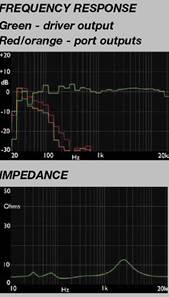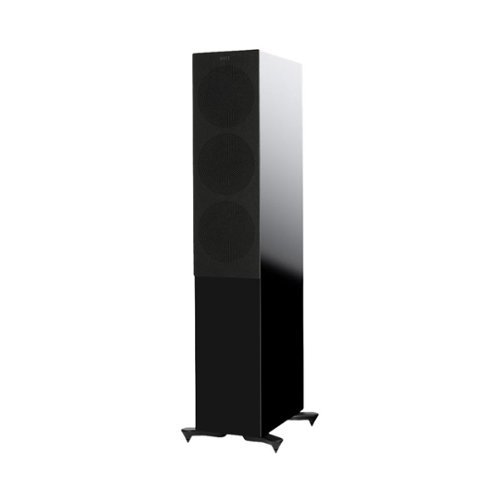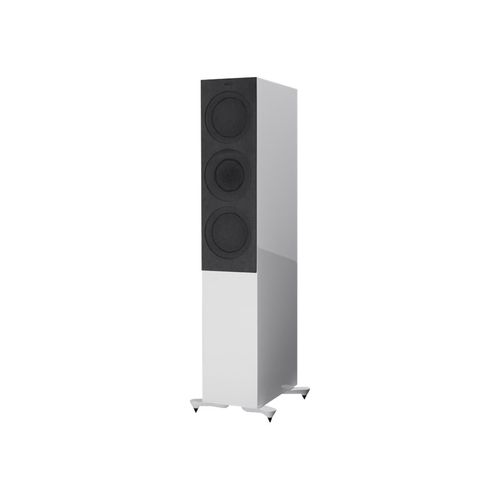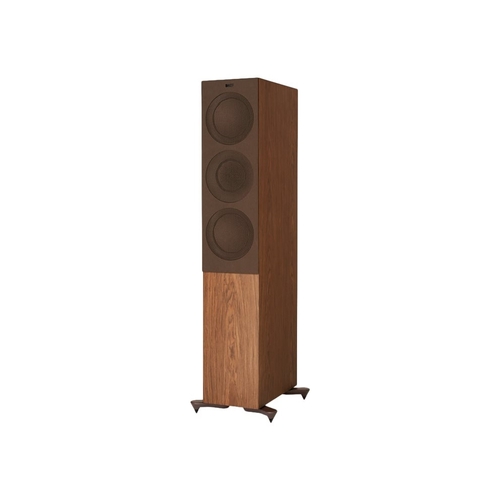KEF R7 Review: Bright Knight
A big floorstanding loudspeaker, KEF’s R7s wow Noel Keywood with their vivid sound. Read our KEF R7 Review.
I thought, when first seeing the R7s “wow, these are big”. They certainly look a little muscular because the cabinet is deep, but KEF disarmingly describe them as a mid-size three way. Which I guess is right, but the R7 is not for limited spaces, either in physical size or acoustic design. We’re talking big sound here, including big bass, for a very reasonable £; it’s easy to pay more (and get less).

Readers say “what do you mean by a big room” and I’d suggest much less than 17ft or so long would be inappropriately small. An R5 would better suit. This is drawn from my own experience where my 17ft long lounge is not ideal for large loudspeakers but our very large office / listening room (6550 cu ft) is perfect, the point being the bass power a loudspeaker like the R7 produces will over-excite a small room causing it to boom. Heavy furnishing, notably big foam filled settees makes a big difference here so it’s impossible to be specific about what will work and what will not. My comments are necessarily general then, but I have to say something to get these loudspeakers into context, rather than flunk the issue.
In KEF tradition, the R7 is a tour-de-force in engineering. The drive units are all designed in-house, notable amongst them being the central Uni-Q drive unit with its ‘tangerine’ waveguides (fins). This is two drive units in one. At centre is an aluminium dome 25mm (1in) tweeter. It is surrounded by an aluminium cone mid-range unit in what KEF term a co-axial arrangement.
The point they’re keen to make here is that the acoustic centres of the two units are aligned axially (front to back) to eliminate acoustic phase error between them. Putting tweeter at centre means there’s no vertical distance (gap) between the two units either, as with conventional three-way loudspeakers, so you get a totally cohesive launch of the sound wave into the room. Typically, this sort of drive unit is described as a “point-source”.
Being a technical loudspeaker, as it were, I am being a little technical here, but as KEF have ruefully told me in the past, some people think that what appears to be a single drive unit can’t be as good as two of ‘em! The Uni-Q is two drive units carefully arranged into one space.
Why do this? Because notionally sound is meant to come from one point and you do get a sense of focus and coherence I’ve found, especially noticeable when moving around: the sound stays the same.
How to describe a large shiny black cabinet? Bit like something from ‘2001 a Space Odyssey’. That dates me rather than the loudspeaker, but because the R7s stand 1062mm tall, are 200mm wide and deep at 383.5mm, they loom large, unless the lights are out. This is a big loudspeaker trying not to look it. And the reason for big is to get deep bass. If you want to go low cleanly then it’s a large drive unit to move volumes of air without distortion, and a cabinet to cope. And that’s what the R7 offers whilst trying to disguise the fact. Alternative finishes are white and a walnut veneer.
The woodwork and drivers add up to 31.4kgs (69.2lbs) per loudspeaker, so not an easy lift. KEF supply four bolt-on stabilising feet, plus adjustable spikes. No foam bungs for the ports, to damp bass down in a boomy room. These are easily obtainable and cheap – better than using a pair of old socks!
For bass duties KEF again use aluminium fronted drivers, two of them here. The all-aluminium driver array keeps character consistent; there’s no change in tonal colour, as happens when drive unit materials differ. Aluminium comes across as fast and vivid, suggesting the R7 will not sound dark or damped.
The rear panel carries ports for the upper and lower chambers and they are stagger-tuned our measurements showed, to give smoother low bass output. This also improves the loudspeaker as an amplifier load, again shown by measurement (see Measured Performance). There’s a sturdy connection panel that allows single or bi-wiring, with an unusual screw switch to choose between these modes, rather than removable links.
Build quality and finish are immaculate. The front grilles can be removed easily, being held by magnets.
SOUND QUALITY
I drove the R7s from our Creek Evolution 100A amplifier connected to an Oppo BDP-205D Universal player to spin CD. Hi-Res came from an Astell&Kern AK120 portable player hooked up digitally through an optical cable to the Oppo’s digital input, so again this puts the internal ESS ES9018 DAC into play, for a smooth sound. They were given a 72 hour run-in.

KEF’s unique Uni-Q co-axial mid- range/treble unit with Tangerine waveguides. Stiffening ribs in the midcone and a smooth flare into the front baffle.
Although I mention bass output a few times in this review, in use within our large listening room (26ft x 18ft x 14ft) the R7s came over as well balanced: there was no obvious or thundering bass. Yet at the same time there was laconic ease in delivering very low subsonic bass, the point here being the KEFs don’t emphasise lows for effect – which you can do from a cabinet of the size – but just get on with being correct.

The connection panel carries bass and mid/treble inputs for bi-wiring, but they are connected by a simple screw switch for mono-wiring.
And when listening that meant almost drifting deep lows from tracks like Loreena McKennnitt’s Gates of Istanbul (CD), where there was powerful presence to low bass but it did not overwhelm.
The R7s came over as academically well controlled, but able to deliver cleanly. The striding bass line in Skunk Anansie’s Hedonism (CD) was easily and clearly displayed in front of me – no hesitation, no limitation. As you can hope and expect from KEF, since they came up with the way to understand and design a loudspeaker for clean bass (Thiele Small parameters) long ago: the R7s are not about to get bass reproduction wrong. There is the room to consider of course, and it substantially affects what you hear – and therefore what I say – but if you have a decent sized room then the “medium sized” R7s are going to drive it well at low frequencies to give great sounding bass.
Yet it wasn’t the deep and powerful bass of these loudspeakers that most captured my attention, rather than their projection of vocals. They are slightly emphasised in the upper mids and this served to push out Josefine Crohholm singing In Your Wild Garden (CD), making her vivid in front of me. The all-aluminium drive unit array and the subtle balances wrought in the R7 make it forward whilst being correct at the same time – yielding a very sophisticated balance.
Whilst the mid-range is forward, there is no searing treble. With Dave Brubeck’s Take Five (CD) cymbals were finely wrought and sweet in character, obvious yet not overwhelming. The whole performance came together nicely to sound sharply defined, clear and pacy, with no bits sticking out – like emphasised sibilants for example. KEF avoid all this, treading a path right down the accurate middle; not bright, not warm. Not dark either, quite a sheeny balance that’s well lit.
Guessing a valve amplifier would suit, even enhance the R7s, I connected up our Icon Audio Stereo 30SE single-ended valve amplifier – and this was an interesting combination. The loudspeakers remained on the sheeny side: there was no softening effect – as some expect from a valve amplifier. However, there was a more relaxed and natural presentation that also better revealed stage depth. This worked well with Arcadi Volodos playing Liszt’s Vallee d’ Obermann, where the space within his Steinway piano and around it – likely picked up by one or two microphones – made for an atmospheric “being there” sound. It also added to the sense of scale. And that is what I heard with the Chicago Symphony Orchestra playing Korsakov’s Scheherazade: kettle drums sat well back whilst higher strings at left came over as well lit and obviously forward on the stage. The R7s were able to retrieve all this information and place it on a wonderfully svelte sound stage, cohesive, smooth and deeply revealing.
MEASURED PERFORMANCE
Frequency response of KEF’s large R7 floorstander ran basically flat from 30Hz up to 20kHz – a very wide range. The lower port peaks at 30Hz (orange trace) and the upper port at 40Hz (red trace); they are staggered in deep bass output for consistent bass delivery. This also reflects back into a peak-free impedance curve. The R7 is a big-bass loudspeaker that runs very low so it is best in a large-ish room. There is some overall lift in lower midband output (+3dB), enough to add warmth and body to the sound, ensuring it isn’t ‘dry’, as perfectly flat loudspeakers can be.

The output of the Uni-Q unit from 1kHz upward is smooth and notably peak free. Smoothness indicates absence of minor resonances, suggesting low colouration.
Sensitivity was on the low side for such a large loudspeaker, measuring 88dB from one nominal Watt (2.8V) of input. I was expecting 90dB, especially as this is a 4 Ohm loudspeaker at low frequencies and draws heavy current. Modern amplifiers are designed for 4 Ohm loads, so no problem here – and 88dB is still very loud from one Watt. A 40 Watt valve amplifier with 4 Ohm output would do fine, for example.
The large R7s have both deep and powerful bass, measurement shows. They also have a very smooth midband and upper treble, peak free to avoid sharpness or spit. A fine measured performance all round.
CONCLUSION
KEF’s big R7 floorstander is a lot of loudspeaker at the price. It is an engineering wonder and worth hearing for just that alone. What I heard was great smoothness and coherence. Also big bass and a powerful, if not overblown sound. These KEFs are forward and projective; no soft and easy composure here. Not for bright sounding amplifiers and watch out for Class Ds with no meat on the bone.
Paired with a quality linear amplifier however, the R7s have a svelte and dramatic presentation worth hearing.

Upper and lower reflex ports tune the internal bass chambers slightly differently, to smooth low bass and give an even amplifier load.
VERDICT
When you purchase through links on our site, I may earn an affiliate commission. Here’s how it works.
KEF Audio
+44 (0)1622 672 261
www.kef.com
KEF R7 HiFi Speakers REVIEW CONCLUSION - #GREAT SPEAKERS
Welcome to Pursuit Perfect System Video Review Conclusion for the KEF R7 floor standing HiFi Speakers In this video I am ...
















You should have been provided with (2) dual-core foam bungs. They are provided as standard – at least, they were with mine here in the UK. Happy with the speakers .. I am also using them with a Creek 100A integrated amp. I have R7s at the front & R3s at the side* of my living room (*on Solidsteel SS-6 stands). Room far from overly spacious (22″ x 14″ approx), but no boom or sense of cramping. R7s sound good on their own .. or played together with the R3s. Deffo recommended – but better if driven with power in reserve, I’d say. Creek amp no lightweight, but only just there, I reckon.
Mine came with the 2 foam bungs. Itan error on the author’s part. Great review otherwise.
Thanks ! 😀
Nothing fancy about my system—Denon AVR 4700 (125 watts/stereo channel) powered system except for the KEF R7s and 6 surround speakers plus a center channel R2 Meta for a really pleasing home theater experience. Went with the KEFs after auditioning them and hearing the subtleties of Bellatrix Lestrange’s performance in the unbreakable vows scene in “The Half-Blood Prince”. Music and voiced songs sound terrific as well.
Most of what you describe is opposite of what other reviewers have experienced. They are not big or a big bass speaker, as an example. And I certainly wouldn’t put them in your auditorium sized listening room. You don’t date your review, so maybe this is an earlier writing when the line was new, and current models have been updated. Apparently, they do come with bungs, and it’s not clear what’sheeny’ means. mt
I agree with Mort……please date your review, current info is vital. Yeah, what is sheeny? The term doesn’t seem to correlate with some of your other comments, which differ from other reviewers. Also, your syntax and grammar is at times confusing, and you almost contradict yourself in consecutive sentences. A good size room for the 7’s would be 12’to 14’x 16’to 18′. jo